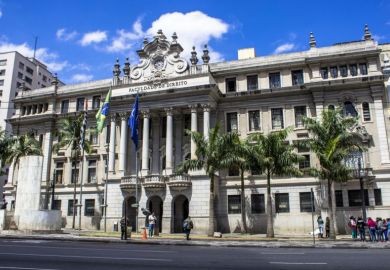Posted by Phil Baty 4 March 2013
The Indian Institute of Science, Bangalore (IISc) has taken the number one position in a new ranking of the top 10 Indian higher education institutions based on their global academic prestige.
Specialist institutes occupy the top five places in the Times Higher Education India Reputation Rankings, published for the first time this year alongside the full Times Higher Education World Reputation Rankings.
IISc - which was conceived by the Indian industrialist J. N. Tata and founded in 1909 - takes first position. Just below it are the Indian Institute of Technology Bombay in second, the All India Institute of Medical Sciences in third, the Indian Institute of Technology Kanpur in fourth and the Indian Institute of Technology Delhi in fifth.
The University of Delhi takes sixth place - the first fully fledged comprehensive university on the list.
The Times Higher Education World Reputation Rankings list the world's top 100 universities based purely on their academic prestige. The 2013 edition, published on 4 March 2013, is based on the results of a survey (view methodology here) of more than 16,600 experienced academics from all over the world who were asked to name a small number of the "best" institutions in their field for both teaching and research.
Of the so-called "Bric" countries with rapidly expanding economies (Brazil, Russia, India and China), India is the only nation lacking a single representative in the overall world top 100.
Phil Baty, rankings editor for Times Higher Education, said: "As a country with a rapidly growing economy and a fine tradition of scholarship, it is a cause for concern that India does not have any institutions that are sufficiently highly regarded by international scholars that they feature among the global top 100 of our World Reputation Rankings.
"But it is clear that there is a need to benchmark the country's performance using recognised global performance indicators such as those employed by Times Higher Education, especially as the country's higher education system is going through such dramatic development and expansion. So we are glad to release this inaugural India Reputation Ranking, which not only gives a sense of the pecking order within India but also shows how far its top institutions must travel to join the elite top 100."
Times Higher Education revealed that if the THE World Reputation Rankings were to list more than just the top 100, India's top-ranked institution, IISc Bangalore, would be 130th. IIT Bombay would sit in 192nd place, but all other Indian institutions would fall outside a global top 200.
"It is encouraging that in terms of global academic reputation, India clearly has at least some highly regarded institutions that have not fallen too far behind the very best in the world," Mr Baty said.
"Reputation is subjective, but it does matters and it has material effects - it can help to attract student and academic talent to India, as well as investment and philanthropic donations. It helps institutions stay competitive.
"But outside IISc Bangalore and IIT Bombay, India's higher education institutions seem to be a long way off in terms of global prestige."
India's Prime Minister, Manmohan Singh, told a conference in February: "Too many of our higher education institutions are simply not up to the mark. Too many of them have simply not kept abreast with changes that have taken place in the world around us...[and are] still producing graduates in subjects that the job market no longer requires..."
Referring to global university rankings that use a range of indicators beyond reputation alone, he said: "It is a sobering thought that not one Indian university today figures in the top 200 universities of the world today."
Philip Altbach, director of the Center for International Higher Education at Boston College in the US, said: "The IITs and IIMs are the only Indian 'name brand' in higher education. For almost half a century, they have maintained high standards of quality and have produced bright graduates who have made their marks worldwide. Their faculty members have produced some excellent research. But these institutions are not really universities - they are small, quite specialised institutions that provide mainly undergraduate education."
And Professor Altbach warned that even the IITs faced some difficulties. "They are having trouble attracting top-quality faculty members in an environment where the private sector provides much higher salaries, and a number of new IITs and IIMs have been opened in obscure parts of the country where it will be difficult to entice top students and professors."

Phil Baty is editor, Times Higher Education Rankings
Register to continue
Why register?
- Registration is free and only takes a moment
- Once registered, you can read 3 articles a month
- Sign up for our newsletter
Subscribe
Or subscribe for unlimited access to:
- Unlimited access to news, views, insights & reviews
- Digital editions
- Digital access to THE’s university and college rankings analysis
Already registered or a current subscriber?



